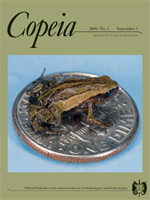Terrestrial habitats around wetlands are important in wetland conservation because many vertebrate animals use them during part of their life cycle. There is relatively little information concerning terrestrial habitat use by aquatic snakes adjacent to wetlands. Radiotelemetry was used to study the spatial ecology and terrestrial habitat use of Nerodia e. erythrogaster in the upper coastal plain of northern South Carolina. Snakes used terrestrial habitats extensively during the summer and fall. Use of both wetlands and southern mixed hardwood forest were significantly greater than predicted by habitat availability within the snakes' home ranges. Agricultural fields were used significantly less than predicted. A distance of 344 m from wetlands is necessary to encompass 95% of the terrestrial localities documented in this study. Home range estimates based on 95% fixed kernels were significantly larger than those calculated using the 95% minimum convex polygon methods. Home range estimates for this species are comparable to those of large terrestrial colubrids and are greater than home range estimates reported for congeners. Snakes spent an average of about ten days out of wetlands during terrestrial movements with a maximum of 23 consecutive days spent out of a wetland. These results suggest that in excess of 300 m of forest habitat buffering wetlands may be necessary to sustain populations of N. erythrogaster.
How to translate text using browser tools
3 September 2009
Core Terrestrial Habitat Around Wetlands: Contributions from the Spatial Ecology of the Redbelly Watersnake (Nerodia erythrogaster erythrogaster)
Jeffrey D. Camper
ACCESS THE FULL ARTICLE

Copeia
Vol. 2009 • No. 3
September 2009
Vol. 2009 • No. 3
September 2009




